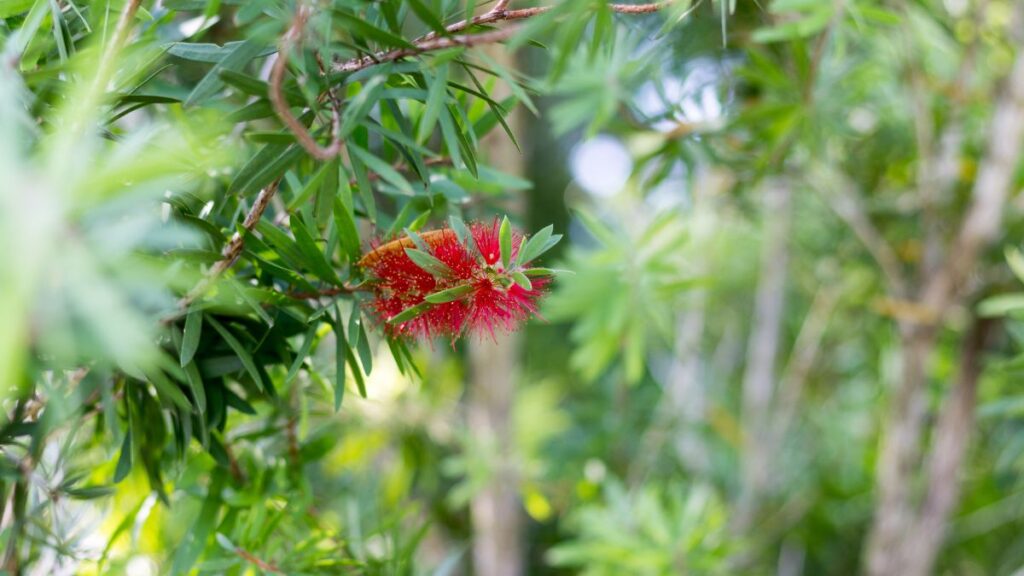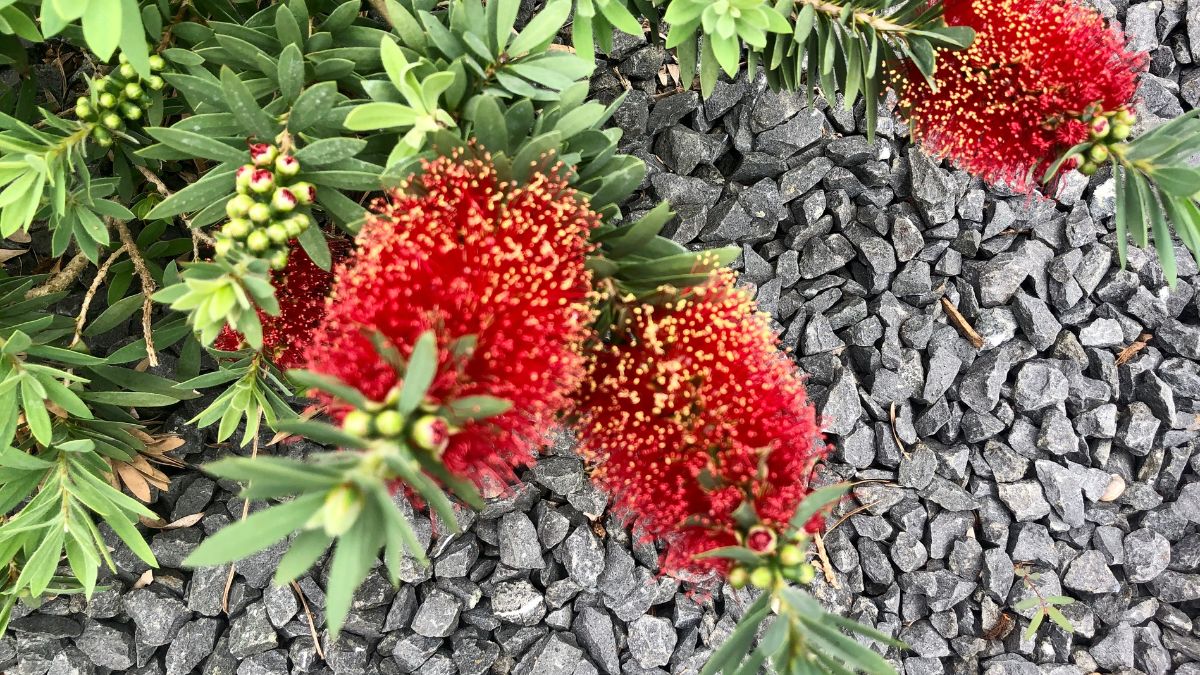Introduction
Bottle Brush Plants
Bottlebrush plants (Callistemon) are renowned for their unique and vibrant flowers, resembling bottle brush brushes. These evergreen shrubs belong to the Myrtaceae family and are native to Australia. With their striking appearance and ease of cultivation, bottle brush plants have gained popularity among gardeners and landscaping enthusiasts worldwide.

History and Origin
Botanist Robert Brown first described the genus Callistemon in the early 19th century. The name “Callistemon” is derived from Greek words meaning “beautiful stamens,” which refers to the prominent stamens found in the flowers of these plants. Native to Australia, bottle brush plants are found predominantly in the eastern and southern regions of the country, where they thrive in various habitats ranging from coastal to mountainous regions.
Varieties of Bottle Brush Plants
Bottlebrush plants are known for their diverse range of species and cultivars, each offering unique colors and characteristics. Some popular varieties include:
- Red Bottle Brush (Callistemon citrinus): Known for its vibrant red flowers, this variety is among the most widely cultivated species.
- Lemon Bottle Brush (Callistemon pallidus): Featuring pale yellow flowers, this variety adds a subtle touch of color to gardens and landscapes.
- Crimson Bottle Brush (Callistemon citrinus ‘Splendens’): With its rich crimson blooms, this cultivar is prized for its intense color and visual impact.
Characteristics and Features
Bottlebrush plants are characterized by narrow, lance-shaped leaves and cylindrical flower spikes resembling bottle brushes. The flowers are composed of numerous small filaments, giving them distinctive appearance. These plants typically have a dense, bushy growth habit and can range in size from compact shrubs to small trees, depending on the species and cultivar.

Suitable Climate and Environment
Bottlebrush plants thrive in warm, temperate climates and are well-suited to regions with mild winters and long, hot summers. They prefer full sun or partial shade and require well-drained soil to prevent waterlogging, especially during the growing season. While they are relatively drought-tolerant once established, regular watering is essential for promoting healthy growth and flowering.
Planting and Care Tips
When planting bottle brush plants, choose a location with plenty of sunlight and well-drained soil. Dig a hole twice the size of the plant’s root ball and backfill with compost and garden soil. Water thoroughly after planting and continue to water regularly, especially during dry spells. Apply a balanced fertilizer in spring to promote lush foliage and abundant flowering.
Pruning and Maintenance
Regular pruning is essential for maintaining the shape and appearance of bottle brush plants. Prune lightly after flowering to remove spent flower spikes and promote bushy growth. Avoid heavy pruning, as this can reduce flowering and compromise the plant’s overall health. Remove any dead or diseased branches as needed to improve air circulation and prevent the spread of pests and diseases.
Common Pests and Diseases
Bottle brush plants are relatively resistant to pests and diseases, but they may occasionally be affected by aphids, scale insects, and fungal infections. To control pests, spray the plant with a mild insecticidal soap or horticultural oil. Ensure good air circulation around the plant to prevent fungal diseases, and avoid overhead watering, which can promote the spread of spores.
Benefits of Bottle Brush Plants
In addition to their ornamental value, bottle brush plants offer several benefits to the garden and the environment. Their nectar-rich flowers attract pollinators such as bees, butterflies, and birds, making them valuable additions to wildlife gardens. They also help to stabilize soil and prevent erosion, making them ideal for planting on slopes or in coastal areas.

Decorative and Landscape Uses
Bottlebrush plants are prized for their decorative appeal and are commonly used in gardens, parks, and public spaces as ornamental specimens, hedging plants, and screening shrubs. They can also be grown in containers on patios and balconies, adding a splash of color to outdoor living spaces. Their vibrant flowers make excellent cut flowers for floral arrangements and bouquets.
Bottle Brush Plants in Gardening Trends
With growing interest in sustainable gardening and native plants, bottle brush plants have become increasingly popular in recent years. Gardeners are drawn to their low-maintenance nature, drought tolerance, and ability to attract pollinators. As more people seek to create wildlife-friendly gardens, bottle brush plants are expected to remain a staple in landscaping and garden design.
Cultural Significance
Bottlebrush plants hold cultural significance in Aboriginal Australian culture, where they are used for medicinal purposes and ceremonial rituals. They are also valued for their wood used in woodworking and craft projects. In addition, bottle brush plants have been immortalized in art, literature, and folklore, symbolizing resilience, beauty, and the natural world.
Sustainability and Eco-Friendliness
As native plants, bottle brush plants play a vital role in maintaining biodiversity and ecosystem balance. By planting native species in gardens and landscapes, homeowners can help support local wildlife and reduce the need for chemical pesticides and fertilizers. Bottlebrush plants are well-adapted to their native environment and require minimal inputs once established, making them a sustainable choice for eco-conscious gardeners.
Conclusion
Bottlebrush plants are remarkable wonders of the plant world, captivating gardeners and nature lovers alike with their vibrant colours, distinctive flowers, and ecological advantages. Whether cultivated for ornamental purposes, to attract wildlife, or as cultural emblems, these adaptable plants have secured their spot in gardens and landscapes across the globe. With the right care and upkeep, bottlebrush plants will persist in enhancing our outdoor environments and enriching our lives for many years to come.

FAQs
Q. Are bottle brush plants easy to grow?
Yes, bottle brush plants are relatively easy to grow, requiring minimal maintenance once established.
Q. Do bottle brush plants attract pollinators?
Yes, the nectar-rich flowers of bottle brush plants attract bees, butterflies, and birds.
Q. How often should I water bottle brush plants?
Water bottle brush plants regularly, especially during dry spells, but avoid overwatering to prevent root rot.
Q. Can bottle brush plants tolerate cold temperatures?
While bottle brush plants prefer warm, temperate climates, some species and cultivars can tolerate light frost.
Q. Do bottle brush plants require pruning?
Yes, regular pruning is recommended to maintain the shape and appearance of bottle brush plants and promote flowering.
